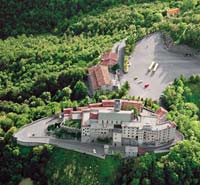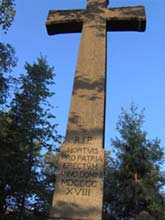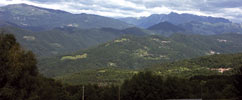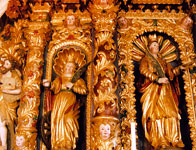![]()

![]()

Presentation
This is a panoramically beautiful itinerary in the
Erbezzo/Arbeč valley with a visit to a few of the
most spectacular votive churches of the Natisone/
Nediža Valleys.
Description of the route
From the sports field of Merso di Sopra/Gorenja Miersa
up to Castelmonte/Stara Gora via the dirt road. From
here along the provincial road to Tribil Superiore/
Gorenj Tarbij. Then along the ridge on the right-hand
side bank of the Erbezzo/Arbeč up to Cravero/Kravar,
to then return to Merso di Sopra/Gorenja Miersa.
Length
The total length of the route is approximately 36km. Here are the kilometres for each section:
Here are the kilometres for each section:
Merso di
Sopra/Gorenja Miersa-Castelmonte/Stara Gora 8km;
Castelmonte/StaraGora-Tribil Superiore/Gorenj
Tarbij 14km;
Tribil Superiore/Gorenj Tarbij-Cravero/
Kravar approximately 7km; Cravero/Kravar-Merso di
Sopra/Gorenja Miersa 6.5km.
Altitude
Approximately 550 metres. Altimetry: Merso di
Sopra/Gorenja Miersa, 168m; Castelmonte/Stara
Gora 618m;
Mount S. Giovanni/Sv. Ivan 702m;
Tribil Superiore/Gorenj Tarbij, 642m; Cravero/
Kravar 480m.
Level of dificulty:
Medium

by a thick wood and it is considered as one of the most attractive places of the base of the Cosizza/Kozca stream valley.

Turn left onto the tarmac road. Having almost arrived at Castelmonte/Stara Gora, on the left a dirt road leads (which is Sentiero Italia, here marked with the red and white Cai trail sign n°748), in less than 1km, to the church of the Tre Re/Sv. Trije Kraji (Three Kings). Intersection with itinerary n° 3 (see page 33).
 from Carnia.
from Carnia.Shortly afterwards there is the Marian sanctuary of Castelmonte (see description on page 24) with a splendid view of the Friulian plain. Intersection with itineraries n° 2 (see page 24) and n°3 (page 33). Continue along the tourist road Castelmonte- Drenchia. With short deviations on the right, it is possible to reach the posts of the First World War on Mount Špik (see page 25) and the church of S. Nicolò/Sv. Miklav¡ (Saint Nicholas) (see page 26).
After approximately 1.5km from the church of S. Nicolò/Sv, Miklav¡, Sentiero Italia (with the red and white Cai trail sign n°747 and a little after also a dirt road which is not marked) turns right and goes into the woods to the beautiful Church of San Giovanni Battista/Sv. Ivan (Saint John the Baptist), positioned on top of Tribil Inferiore/Dolenj Tarbij.


 century, the church of S. Giovanni Battista (Saint John the
Baptist) is on top of the hill, from which there is
a beautiful 360° panorama overlooking all of the
Natisone valleys and the Slovenian Collio.Battista è posta proprio
century, the church of S. Giovanni Battista (Saint John the
Baptist) is on top of the hill, from which there is
a beautiful 360° panorama overlooking all of the
Natisone valleys and the Slovenian Collio.Battista è posta proprio

Going back on your tracks, or continuing along
Sentiero Italia, you return to the tarmac road
and continue to Tribil Superiore/Gorenj Tarbij.
Intersection with itinerary n° 2 (page 28), itinerary
n° 3 (page 37) and itinerary n° 5 (page 48).

of the trenches of the First World War.
Having Reached the cemetery turn left towards
Oblizza/Oblica (3km), Raune/Ravne (a further
1.5km). After approximately 750m turn right towards Cravero/Kravar (again approximately
1.5km) where there are the beautiful churches of S.
Lucia (Saint Lucy) and S. Andrea (Saint Andrew).
 The ceiling of the apse was completely frescoed by the painter Jernej from Škofja Loka. Also Worth noting is the 18th century golden altar by the master Luka Šarf which is rich with decorations; he is also author of the golden altar of the nearby church of S. Andrea/Sv. Štandrež (Saint
Andrew).
The ceiling of the apse was completely frescoed by the painter Jernej from Škofja Loka. Also Worth noting is the 18th century golden altar by the master Luka Šarf which is rich with decorations; he is also author of the golden altar of the nearby church of S. Andrea/Sv. Štandrež (Saint
Andrew).Descend along the ridge of Mount S. Andrea/Sv. Štandrež and get to Merso Superiore /Gorenja Miersa where you can visit the church of S. Antonio Abate (Saint Anthony Abbot).
Return to the sports field of Merso di Sopra/ Gorenja Miersa.